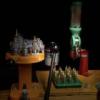Results 11 to 20 of 45
Thread: What do you guys do to keep your blued guns from rusting after being out in harsh environments?
-
06-22-2018, 06:30 PM #11I am a Forum User









- Join Date
- Oct 2015
- Posts
- 6,140
-
06-22-2018, 07:19 PM #12
https://www.amazon.com/Renaissance-X.../dp/B003AJWN62
For weather protection wax is the best way to go IMHO. A couple of buffed coats over the whole receiver and barrel will take a lot of handling and rubbing by brush, clothing etc.
At home storing between seasons, a light coat of Rigg works the best that I have found."Saepe errans, numquam dubitans --Frequently in error, never in doubt".
The trouble with the Internet is that it's replacing masturbation as a leisure activity. ~Patrick Murray
-
06-22-2018, 07:55 PM #13I am a Forum User












- Join Date
- Jul 2009
- Location
- Livonia
- Posts
- 8,476
Just as a general observation, and not directed at the OP, but I've found that many younger shooters aren't familiar with "old time" gun maintenance. They were brought up in the world of plastic stocks and guns, cerakote coatings and the sort. They know plastic pistols will run with no or minimal lube and don't know how to lube a 1911 or other old auto. They don't know the care that walnut and bluing require because plastic pistols and black rifles don't require it.
-
06-22-2018, 09:37 PM #14I am a Forum User












- Join Date
- Dec 2010
- Location
- West of Bravo
- Posts
- 7,508
With the abundance of oxygen on earth, iron wants to be an oxide, not elemental iron. All chemical systems seek their lowest Gibb's Free Energy state. For iron, that is iron (III) oxide (red rust or iron ore). Elemental (metallic) iron has the highest Gibb's Free Energy state. Iron (II,III) oxide (gun bluing) is in the middle.
The chemical kinetics of these transformations at room temperatures are sluggish – almost geological – unless an intermediate reaction which is thermodynamically favorable occurs. Iron reacts very quickly with Group VIIA halogens and Group VIA chalcogens. So if an elemental iron or iron (II,III) oxide (gun bluing) surface is exposed to strong ionic salts or acids in these families, the intermediate reaction is quick. The iron sulphide or chloride formed by these intermediate reactions have Gibb's Free Energy states between iron (II,III) oxide and iron (III) oxide. It is not thermodynamically stable in an oxygen containing environment. So a further ionic exchange occurs, with the sulphides and halides oxidizing down to iron (III) oxide.
All non geological oxidation of iron and steel surfaces is either electrolytic or pyrochemical. Combustion is not relevant to firearms corrosion, because it usually occurs above the melting point of iron.
In rainwater corrosion, some ionic molecule dissolved in the water produces an electrically conductive liquid surface film. Salt molecules containing halogens (most commonly NaCl & KCl) are the most common ionic molecules responsible for this kind of rust. The most common sources on firearms are sweat, salt, and corrosive priming residues. Water and other liquids composing the films come from humidity, sweat, rain, and immersion.
The corrosion mechanism is initial chlorine reaction with iron atoms to create iron (II or III) halide, or less commonly iron (III) halate. Chloride (most common halide) or chlorate is then almost immediately converted to iron (II or III) hydroxide drawing on free oxygen ions in the water. Finally the water departs and you are left with iron (II,III) oxide [bluing, uncommon without inhibition] or iron (III) oxide [rust or iron ore, common].
These reactions would not occur without electrolysis. The electrical currents are created by concentration cells (areas of different chemical concentration in the water solution) and topographical cells (microscopic peaks and valleys on the metal surface have different electrical potentials). Mirror polished metal surfaces corrode more slowly than rough surfaces. Prevent the transmission of electrical currents altogether and iron will not corrode, even in the presence of strong – otherwise highly reactive – ionic solutions. This is inhibition. Barium sulphonate is a strong inhibitor.
Most firearms are not deliberately exposed to strong reactive ionic solutions, so how do they alight on firearms surfaces? Ionic salts from perspiration are only a minor contributor to corrosion. Most of the really damaging ionic solutions are the excreta of bacteria, which are widely present in the environment and fingerprint residues. Add oils, fats, and water and the little buggers have a feast. They excrete strong, ionic sulphur compounds which trigger corrosion when wet. Almost all corrosion pitting on firearms surfaces occurs under erstwhile bacteria colonies. Barium sulphonate is a strong antimicrobial.
Summary:
Eliminate water and/or chlorine (and all the other less common halogen & chalcogen atoms), and electrolytic rust does not occur on steel surfaces. The other major corrosion mechanism on steel firearms surfaces is bacterial. Get a bacteria food (sugars, organic oils, fats, soaps, etc) on the surface of steel or iron and bacteria will consume it, then excrete various sulphurous acids which launch you back into electrolytic corrosion.
Or you can apply inhibitors and antimicrobials to the iron surface to prevent corrosion, but there must be a binder to adhere them to the iron surface. Barium sulphonate is the best inhibitor and antimicrobial. Wax is the best binder which can be readily removed.Last edited by 10x25mm; 06-22-2018 at 10:04 PM.
-
06-22-2018, 11:52 PM #15I am a Forum User







- Join Date
- Mar 2009
- Location
- Mid Michigan
- Posts
- 3,621
After a thorough cleaning, I use SC Johnson Paste Wax.
It is easy to apply and is extremely durable.
-
06-23-2018, 01:04 AM #16MGO Member Forum User



- Join Date
- Dec 2016
- Posts
- 254
I would consider myself a "younger shooter", so you can lump me into that group. That being said, I have an affinity for guns with walnut stocks and blued steel which is what almost all of my non military-type rifles are. I'd definitely be interested in any tips you have for taking care of them, and especially when it comes to walnut. I want to keep my walnut stocks looking nice.
And thank you everyone else so far for your input.
-
06-23-2018, 06:41 AM #17"Saepe errans, numquam dubitans --Frequently in error, never in doubt".
The trouble with the Internet is that it's replacing masturbation as a leisure activity. ~Patrick Murray
-
06-23-2018, 07:35 AM #18
Boshield. I've used it for years.
-
06-23-2018, 03:22 PM #19I am a Forum User



- Join Date
- Jun 2015
- Location
- Twin Lake
- Posts
- 112
You just dumped a big steaming plate of marginally applicable information on the table without any attributions or quatation marks. I guess you can operate this way on these sites without risk. Don't get me wrong I don't care one way or the other but you've still barely hit the berm let alone the target.
Regards
-
06-23-2018, 04:19 PM #20I am a Forum User



- Join Date
- Jun 2015
- Location
- Twin Lake
- Posts
- 112
I would tend to recommend Boeshield also. It's about the only product that seems to handle condensation fairly well. ive owned and operated several decent sized woodworking shops over the years and we always paste wax the tables on our saws, shapers, jointers, surfacers etc but even then get some warm moist Spring air into the shop and stuff will freckle and stain wherever the wax film has been scratched or broken. If I am going to wax my fine pieces I prefer Renaissance Wax as it is much easier to apply on irregular gun type surfaces with lots of profile, nooks and crannies. It's a bit pricey but it works. Good old Paste wax may be a bit more work to apply but it achieves the hardest rugged hide, wears the longest and is somewhat self healing when warmed up a bit. And there is a lot to be said for that special time spent handling and looking at every part of your rifle which you'll do when hand waxing. Petting my dogs, oiling, cleaning and feeling my rifles is never wasted time. When I lived and hunted out West we always left our rifles on the porch cause if you brought them in to a heated room they would sweat something fierce.
RegardsLast edited by garbler; 06-23-2018 at 04:38 PM.
|
|





 Reply With Quote
Reply With Quote




